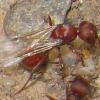1. Is there terminology for early small-sized workers? I know that the first ones are nanitics, but what about the later generations that are still not full-sized? Is there a word for them?
There are lots of different sizes of workers in most ant species. Pretty much the only ants that do not have size differences between workers are dinosaur ants and ponerine ants. The smaller workers usually tend the brood or excavate food from spaces the larger workers cannot reach (like the inside of a dead grasshopper). Even in old colonies you will always find workers that are barely bigger than nanitics.
2. How long does it take until a captive colony produces full sized workers? I'm sure it varies by species, but I'm particularly interested in a Camponotus colony I have. They are reproducing very fast (at least 200 workers since I found the queen last June). Any guesses how long until they produce workers that approach full size?
My Camponotus colony produced full-sized workers from their second batch on. Actually the sixth worker they raised became a media worker and it's still quite a monstrosity compared to the 20 others they now have.
Which kind of workers an ant colony raises is often linked to the amount of protein they can gather and the challenges they are faced with. I'm pretty sure they made a media worker as a storage container because I fed them so much protein and as walking crowbar to break apart the spiders and superworms they got fed with.
Edited by Serafine, June 6 2017 - 4:47 PM.
















